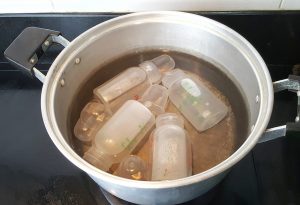In this Article
- When To Introduce A Bottle To A Newborn?
- Selecting a Feeding Bottle for Your Baby
- How Much and How Many Times You Should Bottle Feed Your Baby?
- Should You Combine Breastmilk and Formula?
- Sterilising the Feeding Bottles
- Best Way to Warm a Feeding Bottle
- Signs That Indicate That Your Baby is Hungry
- How to Know That Your Baby is Drinking Comfortably?
- How to Bottle Feed a Baby?
- Bottle Feeding Problems
- Advantages of Bottle Feeding
- Disadvantages of Bottle Feeding
- Weaning From Breastmilk to Bottle Feeding
- Is It Ok to Store Feed in Fridge for Later Use?
The World Health Organisation recommends exclusive breastfeeding for the first 6 months of your baby’s life, because of the many benefits that breastfeeding can offer your baby. However, breastfeeding can be a challenge for some mothers, and for those who face this challenge, this article will help you understand all about bottle feeding.
From wanting to resume work to being unable to produce enough breastmilk for the baby’s needs, there are several reasons why a mother may decide to introduce a baby to bottle-feeding. This article discusses all a new mother needs to know about the nuances of introducing a bottle to her baby.
When To Introduce A Bottle To A Newborn?
Lactation experts recommend that a mother wait to introduce the bottle to her baby until breastfeeding is completely established and the baby has learnt to latch on perfectly. Based on your schedule or the baby’s need for extra nourishment, you can introduce the bottle to your baby. It takes a baby at least 2 weeks to be accustomed to feeding from a bottle.
Selecting a Feeding Bottle for Your Baby
Choosing the right bottle for the baby is important. If your baby is very young, then start with a slow-flow bottle. Once the baby is accustomed to the flow it is time to introduce a bottle with normal flow. The best feeding bottles are ones which are BPA (bisphenol-A) and EA (oestrogen activity)-free bottles.
How Much and How Many Times You Should Bottle Feed Your Baby?
Initially a bottle-fed newborn will start by drinking 30-60 ml milk like breastfed babies. After 2-3 days the baby’s requirement may increase to 60-90ml. Also, feeding the baby every 3-4hrs is recommended initially. Babies tend to sleep in between feeds for 4-5 hrs, but it’s important that you wake the baby up every 5 hrs for a meal. After the first month your baby will increase her intake to 120 ml or so and will need to be fed every 4 hours. This will gradually increase to 180-240ml, 4-5 times a day till she reaches the 6th-month mark.
Should You Combine Breastmilk and Formula?
Combining breastfeeding and formula-feeding is the perfect way to ensure that your baby gets the best of both. If you plan on returning to work, then substituting a few breastfeeds for bottle feeds and later breastfeeding the baby at night will create a good balance.
Here are few tips to on how to combine breastmilk and Formula:
- You can drop your daytime feeds slowly and introduce bottle-feeds. Doing this gradually will prevent your milk supply from reducing drastically and also prevent breast engorgement.
- Feeding breastmilk early in the morning and in the evening provides your baby with plenty of nourishment.
- When you are at home it’s better to offer breastmilk first and supplement with formula after the feed if necessary.
- Also it is not a good idea to mix breastmilk and formula in the same bottle as the mixture may spoil.
Sterilising the Feeding Bottles
It is important to sterilise feeding bottles and all their attachments until the baby is 1 year old to keep infections at bay. Here are few tips on how to sterilise feeding bottles:
1. Washing Feeding Bottles
After every feed, bottles, teats, and any other feeding equipment must be washed with hot soapy water and rinsed well.
Keep aside a cleaning brush only meant for the feeding bottles and a smaller brush for the teats. Reverse the teats and wash them with hot soapy water Instead of strong detergents use regular liquid soap or a baby-specific liquid soap.
Remember to rinse all the feeding equipment with cold water to make sure there isn’t any soap left on it.
2. Sterilising a Feeding Bottle
Here are a few ways in which you can sterilise feeding bottles:
- Traditional boiling method – Sterilising feeding equipment with boiling water is the oldest method. Boil the feeding equipment in water for 10 mins. Make sure all the equipment is submerged in water. Do check the bottles and teat regularly as boiling them at high temperatures may lead to damage.

- Microwave or Electric steriliser – Feeding equipment can also be sterilised in the microwave or an electric steriliser. You will need to follow the manufacturer’s instructions of the feeding bottle steriliser and follow them. Make sure all the bottles and teats are facing downwards inside the machine, and the equipment is left inside only for the recommended time.
- Sterilising Solution – You can also use sterilising solutions available in the market. Follow the manufacturer’s instructions. Just make sure all the equipment is fully submerged in the liquid.
3. After Sterilising
It’s best to leave the feeding bottles in the steriliser until needed. If you are following the boiling method, then remove the bottles and close them up with the teats and lid until needed. Make sure you wash your hands before touching the bottles.
Best Way to Warm a Feeding Bottle
Babies tend to get a bit fussy if their favourite food isn’t served up the way they prefer it. Here are few tips on what is the best way to warm a feeding bottle:
1. Using a Bottle Warmer
All you need to do is fill water into the bottle warmer, fit the bottle in place, switch it on and 4-5 mins later you will have a perfectly warmed bottled ready for the baby.
2. Using a Bowl of Warm Water
Fill warm water in a deep bottle and place the feeding bottle with the teat open. Make sure you don’t leave it for more than 10-15 mins to avoid bacteria growth.
3. What to Avoid
- Avoid using a microwave to warm a feeding bottle. This will heat milk unevenly and create a hot pocket of milk which is dangerous for the baby.
- Avoid warming the same feeding bottle twice, because when milk is boiled and left to cool, bacteria starts to breed. Hence its best to discard the milk and make a fresh batch for the next feed.
Signs That Indicate That Your Baby is Hungry
Keep an eye on the baby’s hunger cues. Just like breastfed babies, bottle-fed babies show cues like rooting response, suckling, searching for the breast and also smacking lips.

If your baby is bottle-fed then you have an exact idea of how much milk your baby is drinking. Here are few signs which indicate that your baby is hungry:
- The baby should be fed at least 6-8 times a day on an average. Your baby will also regularly ask for feeds.
- You will be able to hear baby swallowing milk once she has latched on properly and the milk has let down. Your baby stops drinking and immediately detaches when she is full.
How to Know That Your Baby is Drinking Comfortably?
Sucking milk from the breast and from a bottle requires different mouth and tongue movements. Hence, the baby will need some time to get adjusted and be able to swap between the two easily. Here are few tips on how to bottle feed a breastfed baby:
- Pick the bottle best suited for baby.
- Get someone else to the feed baby because she needs to get used to being fed by someone other than you to get them adjusted to your unavailability.
- If you are supplementing with formula, start with small amounts and always after a breastfeed. This way the baby will have time to adjust to the change.
- Give your baby time to adjust. There may be instances baby may not drink much milk during the day and wake up for a breastfeed at night.
How to Bottle Feed a Baby?
Feeding time is the best time to bond with your baby. Here are few tips for bottle feeding a newborn baby:
- Always feed the baby in an almost upright position, that is, while cradling the baby in the crook of your arm. This not only makes it easy for the baby to drink without gagging, but also ensures eye contact while feeding.
- You can also feed baby in a sitting position, where the baby is sitting in your lap and you are holding the bottle in front.
- While feeding, always tilt the bottle so that the nipple is filled with milk and has no place for air; this will reduce chances of gas.
There isn’t any perfect way or bottle feeding. Any of the above methods is fine as far as the baby isn’t sleeping or lying on her back while feeding from a bottle.
Bottle Feeding Problems
Like breastfeeding, bottle-feeding too has its own problems. Here’re are few you may come across while bottle-feeding your baby:
- If the bottles are not sterilised well your baby can catch infections that may lead to diarrhoea or vomiting.
- Wrong feeding position may make your baby gag while feeding, especially if you feed the baby in a sleeping position.
- Feeding bottles tend to have trapped air, which, in turn, makes the baby gassy. Regular burping in between feeds can minimise this. Dress your baby in clothes which are loose around the tummy.
- Always hold the baby upright after a feed to avoid spit ups.

Advantages of Bottle Feeding
The next best alternative to breastfeeding is bottle-feeding. Bottle feeding has both advantages as well as disadvantages. Let’s take a look at the advantages:
- When a baby is bottle-fed, you can measure exactly how much milk the baby is consuming.
- Bottle feeding enables other members in the family to feed the baby. This not only encourages a bond with the other family members, but also gives the mother a much-needed break.
- Mothers who exclusively bottle-feed need not worry about their diet.
- Mothers who bottle-feed can get back to their pre-pregnancy habits earlier.
Disadvantages of Bottle Feeding
The disadvantages of bottle feeding are:
- Though formula does have nutrients that help the baby grow healthy and strong it lacks some nutrients that help boost brain growth. Breastmilk provides immunity and is fortified with iron.
- Breastmilk is also easier on baby’s digestive system and the body can break it down easily.
- Mothers who breastfeed are less likely to develop breast cancer, ovarian cancer and osteoporosis.
- Bottle feeding can be inconvenient during night feeds, as waking up and preparing a bottle can be strenuous when compared to the simple method of breast feeding.
Weaning From Breastmilk to Bottle Feeding
Transitioning from breast to bottle may take time but it will eventually happen. Here are a few tips which are sure to make weaning less traumatic and stressful for both mother and baby:
- It’s best to start weaning a month or two before your target date. This will give you both enough time to settle into the change. Start the process gradually so that you don’t end up with painful engorged breasts.
- Start with the feed that baby least enjoys, like mid-morning or mid-afternoon, and substitute a bottle for the breast once in a day, to help baby get used to it.
- Save their favourite breastfeeds like early mornings and late nights for some snugly time together. It also helps if the person who is bottle-feeding isn’t mommy because when mother’s milk is readily available, the baby might refuse the bottle.
- Pain and engorgement are unavoidable when you start weaning the baby. Your breasts produce milk on a demand-supply basis, ant it will take time for your body to get into sync. Express some milk to reduce the engorgement, but don’t empty your breasts, as this will send a signal to the body to make more milk.
Is It Ok to Store Feed in Fridge for Later Use?
Formula milk which has been kept outside for more than 2 hours should be discarded due to bacterial growth. Unused formula milk can be stored in a bottle in the refrigerator for up to 24 hours.
While some women choose to bottle-feed because of personal preferences or because they plan to return to work, others need to do so owing to medical constraints. Whatever the reason may be, following these simple tips is sure to ensure a smooth transition for both the mother and the baby.









